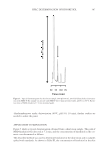APPLICATION OF PURPALD® FOR DETERMINATION OF CARBOXALDEHYDES 395 OPTIMIZATION OF ANALYTICAL CONDITIONS A wide range of parameters leading to the highest absorbance of the corresponding pur- ple product should be taken into consideration to establish optimum conditions for spec- trophotometric determination of 3-cyclohexene carboxaldehydes. The optimal conditions for the course of reaction of 3-cyclohexene-1-carboxaldehyde were established in prelimi- nary tests. The following parameters can be enumerated for exemplifi cation: analytical wavelength optimum reaction time and concentration of sodium hydroxide, Purpald® solutions, and organic solvent. The selected optimal conditions were used to determine different amounts of both compounds and to establish determination ranges for 3-cyclo- hexene-1-carboxaldehyde and hydroxyisohexyl 3-cyclohexene carboxaldehyde. The reaction takes place in an alkaline solution of Purpald® in the presence of oxygen and yields a violet derivative that absorbs most strongly at 538 nm (Figure 3) for both com- pounds. This is caused by identical structure of chromophores (conjugated system) in both derivatives. According to the literature reports (15,19,26), the purple colored prod- ucts of this reaction absorb most strongly in the region of 520–550 nm. The effect of derivatization reaction time on the absorbance value was studied. The maximum intensity was obtained after 45 min of reaction initiation of cyclohexene-1- carboxaldehyde with Purpald® (Figure 4). Several reports have described that in many cases, the time of analysis, which uses Purpald®, ranges from 15 to 25 min (15,21,23,26). The optimal reaction time for the studied aldehydes is 45 min. The structure of aldehyde infl uences this value. The presence of the ring and the double bond causes a higher steric hindrance, which may slow down the reaction of aldehydes with Purpald®. As a result, the time required to obtain maximum absorbance is longer. Figure 3. Absorption spectrum of the colored products (produced from the reaction between Purpald® and determined compounds solutions) and absorption spectrum of used lotion caldehyde = 2.0·10−4 mol·l−1, cPurpald® = 1.0·10−2 mol·l−1.
JOURNAL OF COSMETIC SCIENCE 396 The colors of the products are stable for 10 min therefore, the absorbance decreases with increasing reaction time (Figure 4). Therefore, the measurements of absorbance must be made immediately after stopping the derivatization reaction. The problem of instability of the solution also applies to Purpald®. The derivatization reagent solution develops slight purple color within approximately half an hour. There- fore, for the determination of compounds with this reagent, the freshly prepared solution must be used. The concentration of sodium hydroxide solution has a strong infl uence on the reaction of Purpald® with aldehydes. The best pH for the reaction was that provided by 1 mol·l−1 sodium hydroxide solution (Figure 5). Several reports have also described the infl uence of sodium hydroxide solution on determination of aldehydes (15,17,19). These studies have also chosen 1 mol·l−1 sodium hydroxide solution as the optimum concentration for deter- mination of aldehydes. Excess of sodium hydroxide solution causes a great decrease in the intensity of the produced color. The reason is probably too strongly alkaline reaction medium, which negatively infl uences the stability of the derivative of 3-cyclohexene-1- carboxaldehyde or Purpald® solution. The next studied effect was the infl uence of Purpald® solution concentration on absor- bance values. The maximum intensity was obtained on using optimal Purpald® solution of 0.1 mol·l−1 in 1 mol·l−1 sodium hydroxide solution (Figure 6). The similar concentra- tion of Purpald® solution was selected in many reports as the optimal for proposed proce- dures (15,19,20,22). During the preliminary studies on the optimization of conditions, the samples were di- luted to the mark with methanol. However, this procedure caused the change of color of Figure 4. The infl uence of derivatization reaction time between 3-cyclohexene-1-carboxaldehyde and Purpald® on the absorbance value, caldehyde = 4.0 × 10−4 mol·l−1, cPurpald® = 1.0 × 10−2 mol·l−1.
Purchased for the exclusive use of nofirst nolast (unknown) From: SCC Media Library & Resource Center (library.scconline.org)





















































































